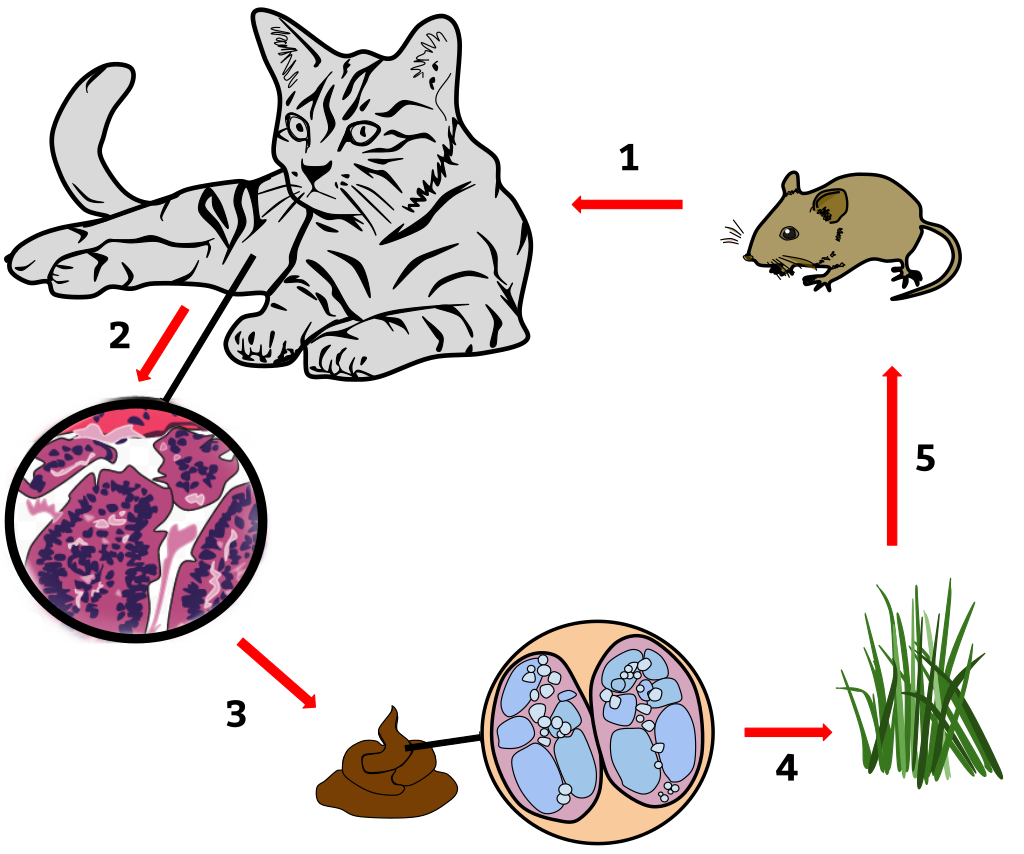3 July 2019
Toxoplasma: A Cat-astrophe?
Posted by Shane Hanlon
This is part of a series of posts from our own Shane Hanlon’s disease ecology class that he’s currently teaching at the University of Pittsburgh Pymatuning Laboratory of Ecology. Students were asked to write popular science posts about (mostly) wildlife diseases. Check out all the posts here.
By Nija Sunil

The toxoplasmosis life cycle. Credit: Wikipedia Commons
Could your pet cat really be carrying a dangerous disease?
Some people might be afraid of adopting cats due to the fear of contracting Toxoplasma, a disease caused by the parasite Toxoplasma gondii which is one of the world’s most common parasites. While this disease is usually correlated to cats it is more often contracted through eating contaminated food.
Cats serve as a host for this parasite and can pass the oocysts in their feces. They acquire the pathogen by eating small infected rodents. While cats don’t show any signs of the infection, their feces are infectious for 2 weeks after the initial infection and the oocyts are infectious
for 1 to 5 days after excretion. This means that the window during which a person can get a Toxoplasma infection is very small. Also if a cat is kept indoors and eats only commercially prepared food there is no chance for infection. Outdoor cats whose litter boxes are cleaned daily pose little risk for infection too since the parasite requires 1-5 days to become infectious. Gardens and sandboxes which are contaminated with feral cat feces pose a greater risk for infection as well as undercooked, contaminated meat.
However if you’re healthy and not pregnant you probably have nothing to worry about even if you do get infected by the parasite. In fact more than 40 million people in the U.S. carry the Toxoplasma parasite, but show few or no symptoms as the immune system keeps the parasite from causing illness. Symptoms of an infection if seen, are similar to the flu and recovery is quick.
Those who are most susceptible to contracting Toxoplasma include pregnant women, immunocompromised people, and children. Pregnant women who have been infected before or during pregnancy can spread the virus to their baby causing miscarriages or severe birth defects. Often infants will not show signs at birth but develop symptoms such as vision loss, mental disability, and seizures later in life. Immunocompromised people such as those who are diagnosed with HIV or cancer are at risk for developing severe symptoms. Some can even develop a relapse if they were infected with Toxoplasma before they became immunocompromised.
Toxoplasma can be treated with a combination of anti-parasite drugs and folinic acid. Pregnant women and infants can be treated before the infection becomes serious but the parasite is not fully eliminated from their bodies. Prevention methods such as handling raw meat with gloves, cooking meat thoroughly, and not handling strays should be used if you are immunocompromised or pregnant.
For otherwise healthy people, toxoplasmosis is nothing to worry about and shouldn’t stop you from adopting that adorable kitten.
Sources:
https://www.cdc.gov/parasites/toxoplasmosis/
https://www.uofmhealth.org/health-library/ug2077










 The Plainspoken Scientist is the science communication blog of AGU’s Sharing Science program. With this blog, we wish to showcase creative and effective science communication via multiple mediums and modes.
The Plainspoken Scientist is the science communication blog of AGU’s Sharing Science program. With this blog, we wish to showcase creative and effective science communication via multiple mediums and modes.